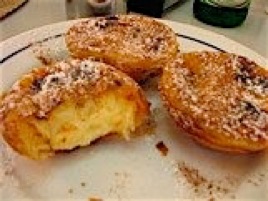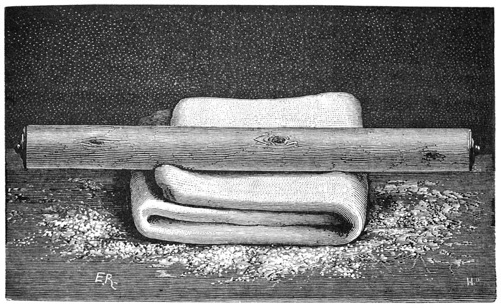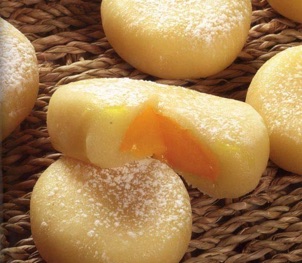A very dense sweet fruitcake containing nuts and spices. It is conceivable that a similar confection was made in Sienna in the Middle Ages. A document as far back as 1205 lists something called
panforte on a list of goods given to the local monks and nuns as a tithe, or tax. Of course it’s anybody’s guess just what went into that ancient
panforte or whether it resembled today’s
panforte in any way at all.
Considered by the Portuguese their national dessert,
pastéis de nata are little puff pastry tarts filled with a egg-yolk-rich custard. The most famous
(and perhaps the best?) are served at the venerable
Pastéis de Belém in a Lisbon suburb where they are typically dusted with cinnamon and sugar. For a recipe see
Leite’s Culinaria. Versions of the recipe appear as early as Domingos Rodrigues’
Arte de Cozhina (1680) which probably means they were around much earlier. They seemed to have been a popular export too, finding their way to Macau, Goa, Angola and Brazil and other spots where the Portuguese raised their flag. From Macau the little tarts were adopted by Cantonese bakers under the name
dan tat.
Pavlova New Zealand, Australia
”A large meringue dessert cake said to emulate the lightness of the famous ballerina, Anna Pavlova” -- Helen Leach,
The Pavlova Story (2008). What distinguishes the Pavlova from a
Windtorte, say, is that the meringue is moist and marshmallow-like on the inside and crisp on the outside. It is usually topped with fruit and whipped cream. Australia and New Zealand both claim that it was invented there either in the 1920s or ‘30s.
Litterally “nigger foot” generally politely translated as street urchin/ragamuffin's foot. In the south of Brazil, this is a sort of peanut brittle while in the north it is a spice and nut cake made with manioc flour. For more see Flavors of Brazil. (Thanks to Scott Barton.)
Literally “nun’s farts” these are relatively, small, yeast-leavened fritters. See also
doughnuts.
p
A Venetian speciality, these take the form of large, dense cookies, about the size of a hockey puck. They are sweetened with molasses, spiked with pepper and typically studded with almonds and raisins.
An almond shortbread-type cookie classically made with lard, though butter-based versions also exist. The name, which comes from the word for powder refers to their delicate, crumbly texture.
Portugal cake US, UK (dated)
This was popular cake on both sides of the Atlantic in the 1800’s. The recipe resembled a poundcake but enriched with sherry and currants. The cakes were baked in pans about the size of a madeleine mold.
A Roman pastry baked in the form of the god of fertility or sometimes just his pertinent member. Roman men ate it at the end of the meal to perk themselves up for post-prandial activities.
puff pastry US, UK, pâte feuilletée France
Pastry cooks have devised two broad ways of making flaky pastry: to make
filo or
strudel dough, a water and flour paste is rolled or stretched very thin and brushed with fat between each layer; to make puff pastry, the fat is enclosed in the paste and then the dough is repeatedly folded and rolled resulting in layers that puff up on baking. Just where this latter idea originated is a little unclear. The earliest recipe for what might be called puff pastry shows up in a 13th century Andalusian source. Here, a flour and water paste is smeared with fat, rolled up in a cylinder and then rolled out once again. This technique is still used to make the pastry for Portugal’s
pastéis de nata as well as Naples’
sfogliatelle. Lancelot de Cousteau called this “Spanish puff pastry”
(
pastéz d’espaigne fueiltéz) in his 1604 French-language cookbook. The first recipe for honest to goodness French-style puff pastry that is repeatedly folded and rolled doesn’t show up until 50 years later. Did the French adapt the rolled Muslim Iberian version? Or did they come up with the folded version independently? There’s probably no way of knowing for sure.
These half-moon shaped fritters are made by filling an eggless pancake with nuts or fresh cheese before frying. A syrup scented with orange flower water or rose water is usually drizzled over them. In many parts of the Middle East they are a traditional treat during Ramadan. Recipes for the pancakes themselves appear in sources as early as the ninth century.
qatayif
quejinhos do céu Portugal
Literally “little cheeses from heaven,” where the “cheese” is made with almond paste and the interior filled with a rich egg custard.
Photo: Antonio Rosado from
Doçaria Conventual Portuguesa, 2004






















